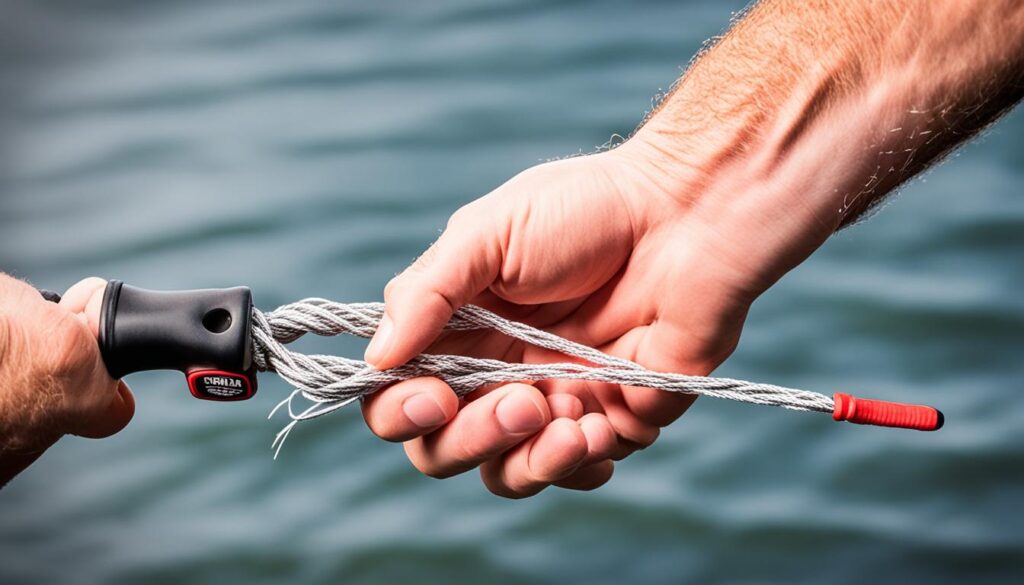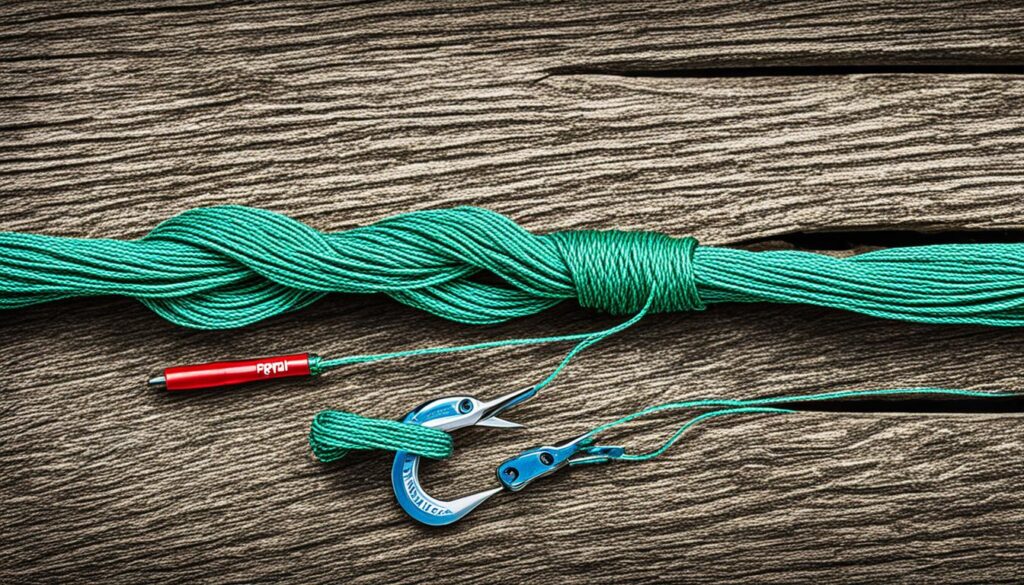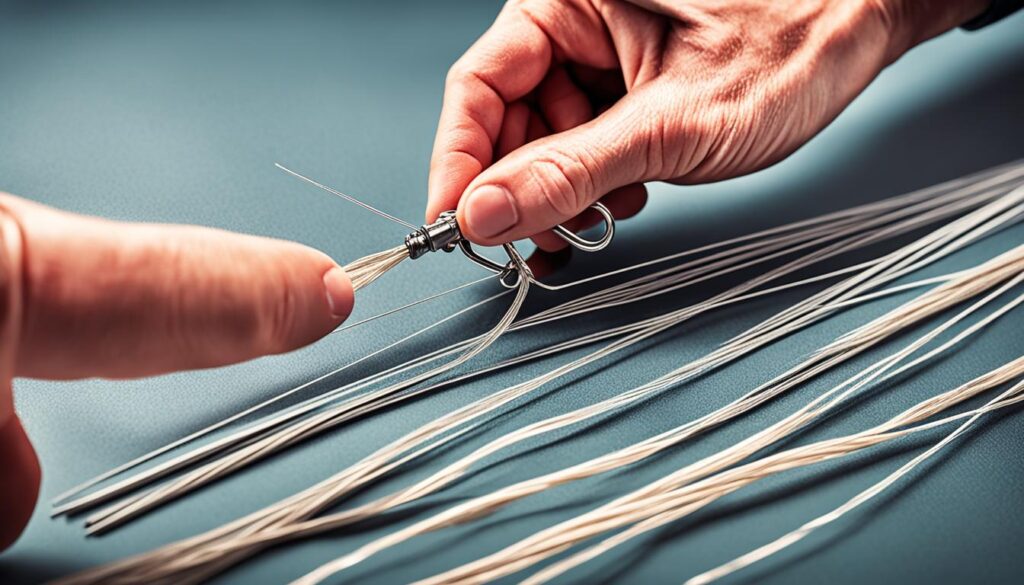Welcome to our fishing knot tutorial. We will show you how to tie the Rapala Loop Knot step by step. It’s a key knot for all anglers, beginner or advanced. Learning this knot will boost your fishing game.
The Rapala Loop Knot is special. The famous Rapala brothers recommend it. They are known for their quality fishing lures. This knot makes your lures move like real fish. With our clear guide and pro tips, you’ll learn to tie it quickly.
Angler’s Essentials:
- Learn how to tie the Rapala Loop Knot for a non-slip loop connection between your fishing line and lure.
- The Rapala Loop Knot provides strength and allows lures to move naturally, increasing their attractiveness to fish.
- Follow our step-by-step knot-tying guide and incorporate our expert tips for the best results.
- You can expand your repertoire by exploring other essential fishing knots, such as the Improved Clinch Knot and Palomar Knot.
- Mastering various fishing knots prepares you for different fishing scenarios and improves your overall angling skills.
Understanding the Rapala Loop Knot
The Rapala Loop Knot is excellent for fishing lures that need to move freely. It makes a loop for lures to move naturally. This helps attract fish. Learning to tie this knot can make you a better angler.
| Fishing Knot | Pros | Cons |
|---|---|---|
| Rapala Loop Knot |
|
|
It’s essential to tie the Rapala Loop Knot right. With a bit of practice, you can get the hang of it. Use a good guide to learn this important fishing knot.
“The Rapala Loop Knot is a game-changer for anglers. Its ability to create a non-slip loop and enhance lure movement has significantly improved my fishing success.” – James Anderson, avid angler
Tying the Rapala Loop Knot Step-by-Step
- Pass the fishing line through the eye of the lure, leaving a long tag end.
- Create a loop in the tag end, overlapping it with the main line.
- Hold the loop and tag end, forming a small loop with the doubled line.
- Twist the lure to create three twists in the doubled line segment.
- Pass the tag end through the loop formed and pull it tight.
- Moisten the knot, and trim any excess tag end if necessary.
Follow these steps, and you’ll tie the Rapala Loop Knot correctly. Keep practicing until you’re good at it.
After you’ve learned the knot, you can use it in many fishing situations. It works well with Rapala lures and others that need to move naturally. It’s a key skill for any fisherman.
Step-by-Step Guide for Tying the Rapala Loop Knot
Here’s how to tie the Rapala Loop Knot:
- Thread the tag end of the line through the lure’s eye. Allow plenty of line for working.
- Make a loop by folding the tag end back towards the lure. This forms a U-shape with your line.
- With the loop and tag end held by your fingers, wrap the tag end around the line four to six times.
- Take the tag end through the loop from above and pull all the way through.
- Wet the knot with water or saliva. Slowly tighten it by pulling the tag and standing line.
- Cut off the extra tag end, leaving about a ¼ inch.
Great job! You’ve completed the Rapala Loop Knot. It’s strong and lets your lure move freely. Practice a few times to make it easy.
Knowing many fishing knots is key for anglers. The Rapala Loop Knot is a good one to learn. Check out other essential fishing knots and tricks to improve your skills and success.
Tips and Recommendations for Tying the Rapala Loop Knot
Tying the Rapala Loop Knot well can boost your fishing game. It helps keep your lures safe and ensures a great fishing trip. Here’s what you need to know:
- Choose the right line: Picking the right fishing line matters a lot. Make sure the line’s strength matches the fish size and weight you’re after.
- Practice makes perfect: Tying this knot requires skill, which you can build with practice. Keep at it until you’re confident in your knots.
- Moisten the line: Wet the line before tightening the knot. This step reduces wear on the line and stops it from breaking.
- Please keep it tidy: Tie the knot neatly and tightly. A messy knot is weaker and can come undone.
- Test the knot: Always check your knot by giving it a good tug. This quick test can prevent you from losing a fish because of a bad knot.
With these tips, you’ll learn to tie the Rapala Loop Knot like a pro. Choosing the right fishing knots is key to a fun and successful day on the water.
| Knot | Strength | Difficulty |
|---|---|---|
| Rapala Loop Knot | High | Intermediate |
| Improved Clinch Knot | Medium | Easy |
| Palomar Knot | High | Easy |
| Surgeon’s Knot | High | Easy |
Why the Rapala Loop Knot?
The Rapala Loop Knot stands out for fishing because it lets lures move naturally in water. Its loop design boosts how the bait looks to fish, making it more enticing. The Rapala Loop Knot brings together strength and adaptability, making it a must-have in your knot-tying skills.

Other Useful Fishing Knots to Learn
The Rapala Loop Knot is just one of many fishing knots worth knowing. Learning these essential knots prepares you for all fishing types. Having a wide array of knots in your fishing skillset is smart.
Improved Clinch Knot
The Improved Clinch Knot is really popular and very reliable. It secures your line tightly to a hook or lure. Its solid and simple design makes it a must-know knot.
Palomar Knot
The Palomar Knot is tough and great for big fish. It can be used to attach hooks, lures, or swivels to your line. Anglers love it for its strong connection.
Surgeon’s Knot
The Surgeon’s Knot is versatile and easy to tie. It joins lines together or adds a leader quickly. This knot is simple and reliable, perfect for many fishing needs.
Learning these essential knots, like the Rapala Loop, Improved Clinch, Palomar, and Surgeon’s, gives you many knot tools. Each has its own strengths. You’ll be ready for different fishing challenges and the fish you aim for.
It’s essential to practice these knots before you fish. Try them with different lines and lures to see what works best for you. Happy fishing!

Conclusion
Tying the Rapala Loop Knot well is vital for anglers who want better fishing luck. This knot helps lures look more lifelike underwater, catching more fish’s eyes. With our easy-to-follow tutorial and expert advice, you’ll master this knot quickly.
Yet, it’s wise to know more than just the Rapala Loop Knot. Add more essential knots to your skill set, like the Palomar Knot and the Improved Clinch Knot. This variety ensures you’re ready for any fishing situation.
Don’t wait to expand your knot knowledge. Whether you’ve just started fishing or have been at it for years, mastering the Rapala Loop Knot and other key knots will boost your fishing adventures. Enjoy the journey!
FAQ
What is the Rapala Loop Knot?
The Rapala Loop Knot is a special fishing knot. It’s used to attach a lure to the fishing line. The Rapala brothers praise it. They’re known for their fishing lures. This knot lets lures move naturally, catching more fish.
Why is the Rapala Loop Knot useful for fishing?
This knot helps lures move freely in the water. This makes them look more real to fish. It also adds strength to your fishing line. Every angler should know how to tie this knot.
How do I tie the Rapala Loop Knot?
You can tie the Rapala Loop Knot by following these simple steps:
Are there any tips for tying the Rapala Loop Knot?
Yes, here are some tips for tying the Rapala Loop Knot for the best results:
Are there other fishing knots worth learning?
Absolutely. Besides the Rapala Loop Knot, you should also know the Improved Clinch Knot, Palomar Knot, and Surgeon’s Knot. Each has its strengths for different fishing needs.
